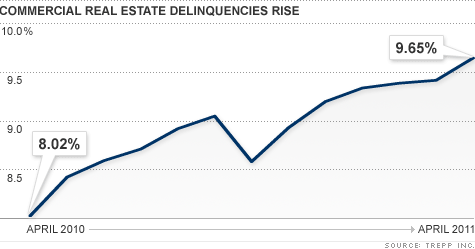Search News

NEW YORK (CNNMoney) -- The troubled commercial real estate is slowly killing off the nation's small and regional banks, and industry experts fear the worst is yet to come.
The delinquency rate on commercial mortgage-backed securities hit a record 9.62% in April, according to a report by Trepp, a firm that tracks commercial real estate and banking data.
Analysts expect that to rise above 10% by year end. On the bright side, that forecast marks a slight improvement over prior estimates that called for defaults to top 12%.
The bulk of these rising delinquencies is falling squarely on the shoulders of the nation's already struggling small and regional banks, forcing dozens to close.
Thirteen banks failed in April, with nearly all them heavily exposed to commercial real estate. It's a familiar pattern that U.S. regulators say they've been observing for several months.
"Commercial real estate is a common thread among the more recent bank failures," said David Barr, spokesman for the FDIC. "When the [financial] crisis started in 2008, most banks got into trouble because of residential mortgages, but in 2009 we started to see that slowly transition over to commercial real estate."
Small to regional banks -- defined as banks holding less than $100 billion in assets -- have $784 billion in commercial real estate loans on their books, according to the Independent Community Bankers Association of America. That's about 71% of the total market.
The biggest reason these smaller banks commandeer such a large portion of the market is because the bulk of commercial lending is "a local business," said Barr
When the housing bubble popped in 2007, those small and regional banks were left holding billions of dollars worth of risky commercial real estate projects. Those included newly constructed vacant buildings as well as unused land.
"While the whole [downturn] was triggered by residential mortgages, commercial real estate has been source of most of losses for the smaller banks," said Matt Anderson, a managing director with Trepp.
At the height of the bubble, small-to-midsized banks underwrote more than $200 billion in risky land and construction loans, where the collateral on the loan wasn't office space but vacant land or incomplete construction sites.
Among the 13 banks shut down last month, commercial real estate loans made up 79% of their non-performing loans, defined as loans in default or close to default. Non-performing residential real estate loans made up only 15% of those loan portfolios.
For example, Cortez Community Bank in Florida, which was shuttered by the FDIC on April 29, had 76% of its loans in commercial real estate. Another failed bank, Nexity Bank of Alabama, had a loan portfolio that was 87% commercial real estate loans.
Surprisingly, the FDIC has had little difficulty finding buyers for these troubled assets. Many local competitors have jumped at the opportunity to grow market share, even though most of these commercial real estate loans remain largely illiquid.
That may be partially due to how regulators have handled the assets by writing loan-loss sharing agreements with the acquiring institution to make the loans easier to digest.
A typical loan-loss agreement will limit an acquiring bank's losses to a fixed percentage, like 20%, with the FDIC carrying the rest of the burden should the loan continue to deteriorate in value.
All of last month's bank failures used some form of loan-loss provisions.
There will likely be more defaults coming down the pike. The national vacancy rate for commercial properties was 17.5% in the first three months of the year, up from 17.2% in the same period a year ago, according to industry tracking firm Reis.
"It's ugly out there, but we are not going to see commercial real estate melt down the point it will need government stimulus like residential real estate," Clancy said. There are pockets of improvement, but those are mostly isolated to higher quality properties in markets such as New York City and Chicago.
"Small commercial projects, the bread and butter of small and regional banks, needs more time before that turns the corner," said William Wheaton, professor of economics and urban planning with MIT's Center of Real Estate. ![]()
| Index | Last | Change | % Change |
|---|---|---|---|
| Dow | 32,627.97 | -234.33 | -0.71% |
| Nasdaq | 13,215.24 | 99.07 | 0.76% |
| S&P 500 | 3,913.10 | -2.36 | -0.06% |
| Treasuries | 1.73 | 0.00 | 0.12% |
| Company | Price | Change | % Change |
|---|---|---|---|
| Ford Motor Co | 8.29 | 0.05 | 0.61% |
| Advanced Micro Devic... | 54.59 | 0.70 | 1.30% |
| Cisco Systems Inc | 47.49 | -2.44 | -4.89% |
| General Electric Co | 13.00 | -0.16 | -1.22% |
| Kraft Heinz Co | 27.84 | -2.20 | -7.32% |
| Overnight Avg Rate | Latest | Change | Last Week |
|---|---|---|---|
| 30 yr fixed | 3.80% | 3.88% | |
| 15 yr fixed | 3.20% | 3.23% | |
| 5/1 ARM | 3.84% | 3.88% | |
| 30 yr refi | 3.82% | 3.93% | |
| 15 yr refi | 3.20% | 3.23% |
Today's featured rates: